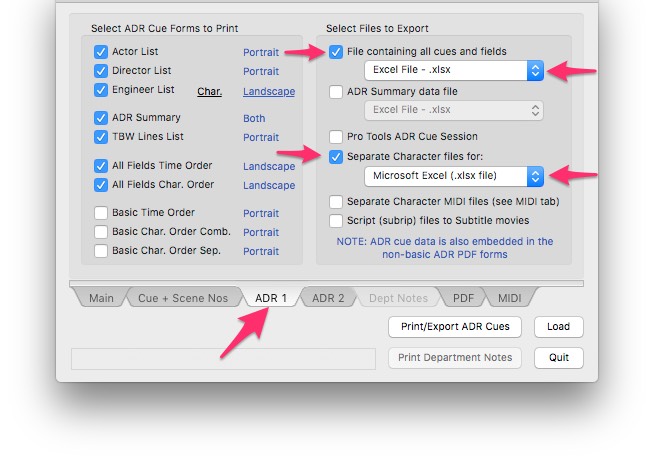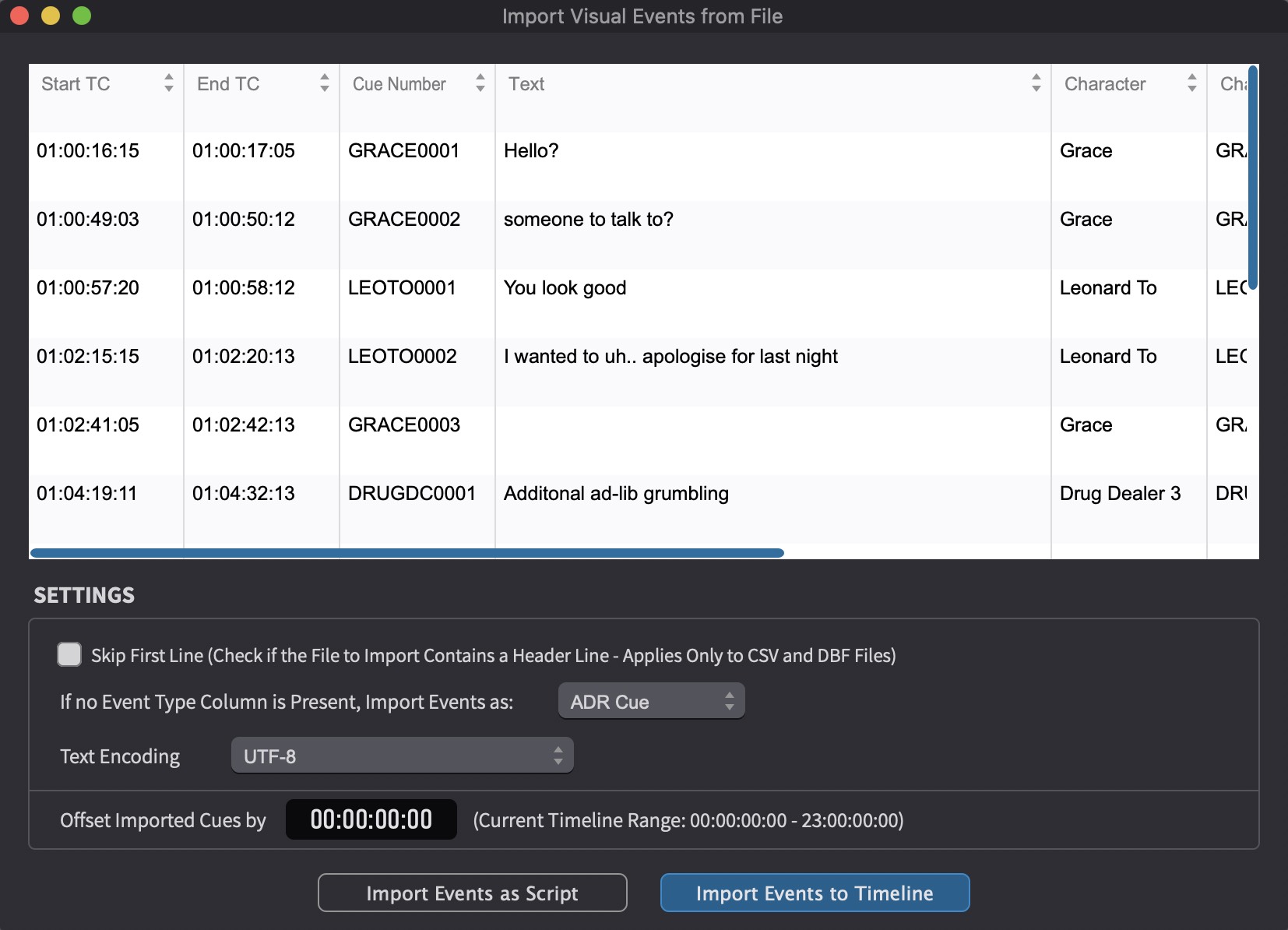Bulk ADR Cue Import from EdiCue
Exporting an EdiCue Session
The following explanation and screenshots are related to EdiCue version 2.8.3, but the steps should be similar for other versions. Please refer to the EdiCue manual for more detailed information.
Once the EdiCue session is ready for exporting as ADR Cue sheets & other associated files, click on the ADR 1 Tab at the bottom of the window.
 {width=70%}
{width=70%}
The ADR for all characters can be exported into one file by enabling the File containing all cues and fields field in the Select Files to Export section of the UI.
For the most efficient import, it is recommended to select Microsoft Excel (.xlsx file) from the format type selection tab.
Excel files use fixed tables to separate data, so there is less likelihood of there being any mistakes in the data formatting compared with text files. Though comma-delimited (.csv) and TAB-delimited (.tab) text files work as well, there is a chance that if some of the ADR text respectively contains commas, tabs, or semicolons - these might cause inconsistent import results.
If so desired, separate files can also be generated for each character by enabling the Separate Character files for: field in the Select Files to Export section of the UI.
Click the Print/Export ADR Cues button.
Setting the Timeline frame rate
It is vital that the frame rate of the Timeline is set correctly before importing cues. Failure to do so, will cause discrepancies in the duration & location of the cues when the correct frame-rate video is eventually added to the Timeline. Setting the frame rate is done either automatically by simply adding video to the current Timeline; or if no video is present, by clicking the pencil icon to the top right of the active Timeline & in the Edit Timeline Settings window that appears, selecting the relevant frame rate from the TC Frame Rate pulldown menu.
Importing
Select File → Import Events from File and choose the exported EdiCue file from the browser window & click Open.
The 'Import Visual Events from File' window
The Import Visual Events from File window will appear next.
The window is separated into two sections: the top section shows the column mapping of the ADR cues in a table-like manner; and the bottom shows the import settings.
 {width=80%}
{width=80%}
ADR Cue Column mapping table
Many of the headings will likely be set to - unused - so each relevant heading will require manual setting to match the heading shown in the first row below it.
Set the following column names in the first row of text to the following respective heading settings:
| Text file heading name | ADR Master table column heading |
|---|---|
| CHAR NAME | Character |
| CHAR ID | Char Prefix |
| ACTOR NAME | Actor |
| CHAR NAME | Character |
| CUE NO | Cue Value |
| CUE START | Start TC |
| CUE END | End TC |
| LINE | Text |
| NOTE | Notes |
| REASON | Reason |
ADR Cue Import Settings section
The bottom half of the Import Visual Events from File window contains a number of import related settings.
 {width=80%}
{width=80%}
Skip First Line - Check this box if importing a file which contains a header line as the first line. ADR Master will use the first line to guess the column mapping and will ignore it for the actual content.
Please make sure before importing whether the file contains a header by inspecting it in a Text editor.
If the file is in Microsoft Excel format, then this setting can be ignored.
Set the If no Event Type Column is Present, Import Events as: field to ADR Cue.
Text Encoding - Set this to UTF-8 or the same setting as used when exporting the EdiCue .csv file.
If you are unsure of the exact text encoding format of the file, UTF-8 is a good default starting point as it also supports non-ASCII characters like Umlauts and other non-US character sets.
Every text file has an internal text encoding. The encoding determines how the file content should be interpreted. A text file basically is nothing more than a sequence of bytes and ADR Master needs to know which character set to use to decode the bytes into human readable characters. That is why it is important to match the same export & import Text Encoding types. It is unfortunately not easily possible to detect the character set programmatically (it usually works for UTF-16 and for UTF-8). If you're uncertain about the text encoding used in the text file, try different text encodings until the best results are achieved. Problems will usually be visible with special characters like German Umlauts for example.
Offset Imported Cues by - add or subtract a defined timecode offset to all cues when importing them. For example, if the timeline start timecode is set to 10:00:00:00, but the imported cue sheet references a 1 hour start, you could simply enter 09:00:00:00 in the text box here to offset all imported cues by 9 hours.
Negative values are also permitted.
To bulk import the cues into the timeline, click the Import Events To Timeline button. The events will appear in the Timeline & in the Event List.
Or to show the cues as a script to add each event manually one by one using the Import Script window, click Import Events as Script.
